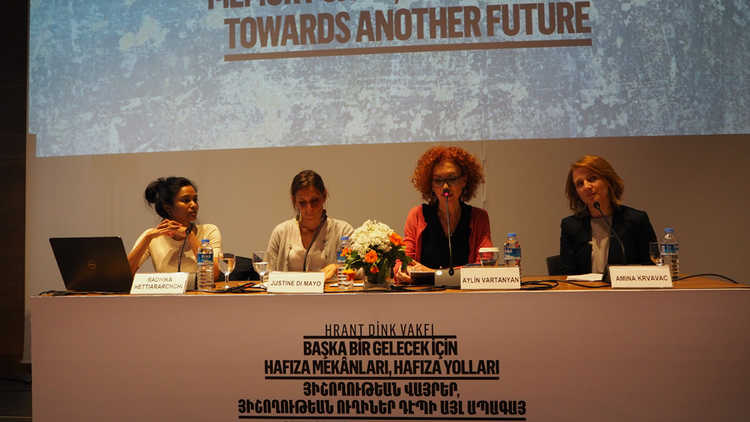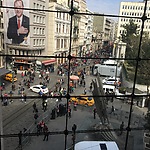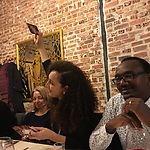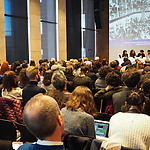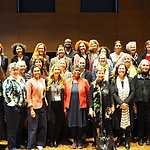The genocides in Ruanda, on the European Jews and on the Armenians, the atrocities of the Kmer Rouge, children growing up during the war in Sarajevo, the Latin American mothers, memories of the civil war in Sri Lanka, traces of the war in Lebanon, apartheid in South Africa and the destruction of District Six in Cape town, the role of Amsterdam in slave trade and New York’s 9/11. One would expect that two days of presentations about the distress and traumas of history by representatives of museums, memory sites and memorialization projects would create a gloomy atmosphere, but on the contrary. The Hrant Dink Foundation set up the conference in order to offer a platform to discuss the present and future of memory works and memorialization of these difficult and violent pasts. Some of the contributions were about very painful experiences, but the delegates showed a remarkable optimism, despite struggles for funding and tough bureaucracy at the best and downright repression from local authorities at the worst. The conference room was full with around 200 students, university professors, representatives from NGO’s and of the embassies of Germany and the Netherlands. Conference room, photo Hrant Dink Foundation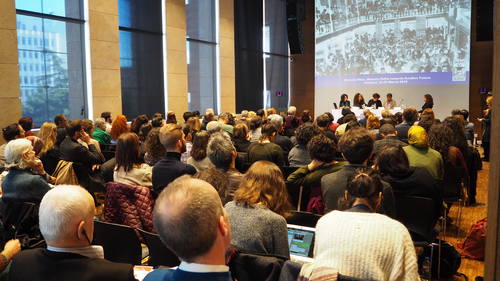
Difficult pasts
The panels focused on the ways these these difficult pasts and traumatic histories are used to remember, to educate and to find new memory paths to the future. ‘Can such a conference take place in Turkey?’, many people asked me before I went. Nayat Karaköse, Program Coordinator of the Hrant Dink Foundation, told us how happy she was that they were able to organize this conference at the heart of the city and that all the speakers accepted their invitation without any hesitation about coming to Turkey. For the organizers, being able to discuss challenging and some taboo topics represented hope despite all the odds.
View from the conference venue, fenches and police at the place where the demonstrations of the Istanbul mothers used to take place. On the wall election posters for Erdogan's AK party. photo Annemarie de Wildt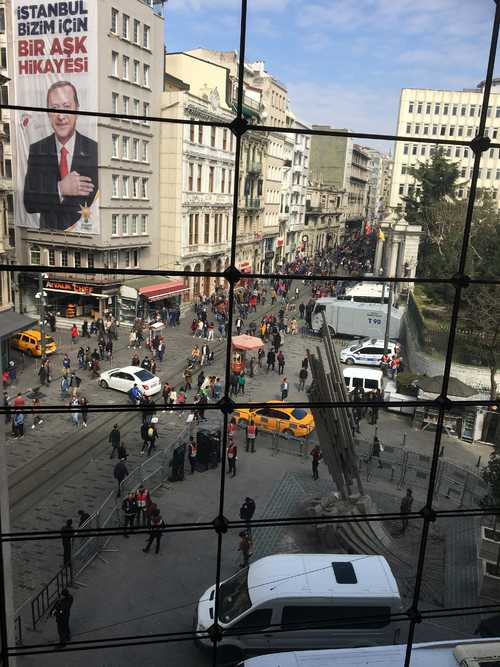
Erdogan was very present in the streets of Istanbul because of the upcoming elections: huge posters, cars with sound systems and video screens with the face and voice of Erdogan. On Saturday morning Diana Taylor spoke in her keynote about the mothers in Argentina and Mexico, who go out on the streets demanding to know about their disappeared beloveds. Meanwhile, downstairs on the pavement of Istiklal Caddesi, Turkish police and military occupied the spot, just next to the entrance of the conference venue, where for years the Istanbul mothers voiced their protest and pain. They have been banned there some months ago. It was equally confronting to meet people at the conference who had spent time in jail or could not go abroad because of a travel ban.
Personal narratives
‘Monumental history needs to be counterbalanced with more intimate pasts’, said professor Marianne Hirsch of Colombia University in her keynote. In some panels personal narratives and memories took centre stage. Radhika Hettiararchchi presented the Herstories Project: stories of mothers about the 26 year civil war in Sri Lanka that act as counternarratives to the nation-building state narrative that excludes minorities. The Memory Map project also encourages empathy and compassion through sharing of memories between generations and between villages. These Sri Lankan sites of conscience and memory are virtual ones, just like the Memory Map of Lebanon. Justine di Mayo explained that the forced reconciliation after the 15 year civil war left little room for individual and collective healing. The memorial site Fushat Amal helps family and friends to find and contribute stories of the estimated 17,000 missing and disappeared. Similarly the 4000 personal objects and more than 200 hours of oral histories collected by the War Childhood Museum in Sarajevo are more than historical testimonies. Amina Krvavac described how the museum is a safe place to tell your story, in the heavily politized society she grew up in, where everyone was were put in a group and was told: ‘this is your story’. Amina and her colleagues have all experienced these war-affected childhoods themselves. The methods for this kind of memory work are exchanged within the International Coalition of Sites of Conscience of which many of the institutions present at the conference are members. Linda Norris of the Coalition is a friend and taking some days off after the conference to wander through Istanbul and continue the conversation, with her an other delegates deepened the experience.
Victims and perpetrators
Conferences are also meeting places. At the welcoming dinner, I sat opposite Paul Rukesha of the Kigali Genocide Memorial where over 250,000 people are buried that were killed during the Rwandan genocide against the Tutsi’s, now 25 years ago. Paul and his siblings lost their parents in 1994. Two days later at the conference, Paul talked about the peace education training, in which over 60.000 people took part. It was not easy to create a program that addresses (children of) victims and perpetrators. It tries to stimulate empathy and critical thinking through storytelling. The Cambodian Tuol Sleng Genocide Museum is housed in the former Security prison 21. Visoth Chhay tells that, just like in Ruanda, stories of victims are told alongside narratives of perpetrators, next to the physical remains, like beds, torture instruments. He adds ‘even bones’, knowing that elsewhere exhibiting human remains is questioned.
But what is the impact of all these stories and different perspectives? Conferences are always more exiting when people share their doubts and dilemma’s. Emilia Potenza of the Apartheid Museum in Johannesburg showed us footage of the new exhibit on the Truth and Reconciliation Commission that was set up to promote re-conciliation and forgiveness among perpetrators and victims of apartheid through the full disclosure of truth. Since 2016 a three screen video in the museum shows the testimonies of a white policeman and of the mother of one of his victims. The museum hopes that visitors will realize that forgiveness and healing are profoundly individual processes that cannot be handled by a committee.
Traces of the past
Spaces can evoke the past in very specific and powerful ways. Mona El Hallak from Beirut calls herself a heritage preservation activist. During the welcome dinner she had showed us a photo of the iconic Ottoman-era Barakat Building she has been fighting for. It housed a photographic studio, a dentist office and many families before the war. After 1975 militias occupied the strategically located building.
At the welcome dinner, photo Annemarie de Wildt
Mona and others have saved the derelict building from demolition and she collected the material traces of the people that occupied it. There have been some exhibitions, but despite promises of the city authorities Beit Beirut (House of Beirut) is still not operating as a museum with a staff and budget. Not astonishing in a country that suffers from ‘state-imposed amnesia’, according to the International Centre for Transitional Justice. For a house in Henrietta Street in Dublin and Castrum Peregrini in Amsterdam artists are invited to create installations that reflect on the aristocratic and tenement life in the building in Dublin and on the many layers of (controversial) history during and after WOII in this Amsterdam canal house.
Which stories to tell about the past of a place? Linda Norris of the International Coalition of Sites of Conscience gave some examples of places that have become more multi-layered in recent years. Monticello, the mansion of Thomas Jefferson, now, after 25 years of research, consultation and discussions has a room dedicated to the enslaved Sally Hemings, mother of Jefferson’s children. Another member of the Coalition is Maison des Esclaves on the isle of Gorée (named after the Dutch island Goeree) in Senegal. A revitalized interpretive presentation will highlight new research about enslavement on Gorée as well as the story of the signares, wealthy mixed race women, who traded and owned slaves. The reactions to the prototype of the new exhibition showed very divergent reactions: ‘I hate the whites’ and ‘I refuse to apologize for being a European’. Linda encouraged us to think of all places as possible sites of conscience. What about a shop for instance: it may be run by refugees. And do we really think of the labor conditions of the people who make the products?
City Museums
Sarah Henry of the Museum of the City of New York made a distinction between traumatic histories, such as 9/11 and contested histories, like their recent exhibitions on germs in the city or the one about Muslims in New York. Amsterdam shares with New York that we have many contested histories and difficult subjects; from the colonial past to the hidden histories of LGBT. I stressed the importance of looking at history in an intersectional way, with attention for the interacting axes of difference, related to class, gender, skin color, ethnicity, age, legal status, being able or disabled. Intersectionality makes us aware on both personal and institutional levels how we are all positioned in a place of power or lack of power.For many of the speakers the subject of their museum or memorial center is their own lived history. They know the story from within. For others, such as us curators in city museums, the question of representation is often urgent. Who is capable or even allowed to tell the history of First Nations in NY, or the history of people enslaved by Amsterdam plantation owners?
Organizers and speakers, photo Hrant Dink Foundation
Nuremberg laws
It was fascinating to see the international threads and connections between all these places. Jennifer Ciardelli of the United States Holocaust Memorial Museum spoke about their present exhibition ‘Americans and the Holocaust’ that shows how Nazi lawyers studied American race laws and the legal system of classification (the infamous one drop rule). The exhibition also reveals how the Depression, xenophobia and racism shaped responses to the Holocaust and Nazism. It was equally interesting to hear about their methods of exhibition making: organize #askwhy sessions to find out what your visitors want to know and built the narrative on those questions. The museum set up a crowd sourced citizens research project, that showed that the African American press wrote much more about racism and anti-semitism than the the white press. I also loved the question the Holocaust Museum would like people to exit the museum with. Not ‘what would I have done?’, but ‘what will I do?’ Later the Nuremberg laws appeared again in presentations about the House of the Wannsee Conference and about the Memorial Nuremberg Trials.
Hrant Dink Memorial
Museums in one part of the world have sparked others somewhere else. Joanna Fikus of Polin Museum told us how a visit to the Washington Holocaust Museum let to the dream of a museum of Polish Jews. The Hrant Dink Foundation found inspiration all over the world, to create an impressive memorial. One of the most moving moments of the conference was on Sunday morning, when we all went to the Stabat building, where the Agos offices were.
We were invited for a sneak preview of the Hrant Dink Memorial where once again the organizers made us feel that our presence was meaningful and empowering. For some of the board members it was also the first time they saw the still unfinished spaces of the memorial. Bonita Bennett of District Six Museum mentions in her blog the ‘moment of great connection’ when advisory board member Ayse Gül Altinay recounted the impression that a presentation about District Six had made on her years ago. The museum about the Cape town neighborhood that was forcibly destroyed after the 1950 group area act, shows that a museum can be a vehicle for social justice. It led to the idea of creating this Memorial in Istanbul. District Six Museum was one of the many places coordinator Nayat Karaköse visited, in a deliberately slow search for the right way to set up a memorial that would not be a shrine for Hrant Dink, but a safe house for his legacy, for the struggle for human rights. If ever I doubt about the capacity of museums and memory sites (including websites) to help people deal with and overcome difficult pasts, I just have to think back of these days in Istanbul.

